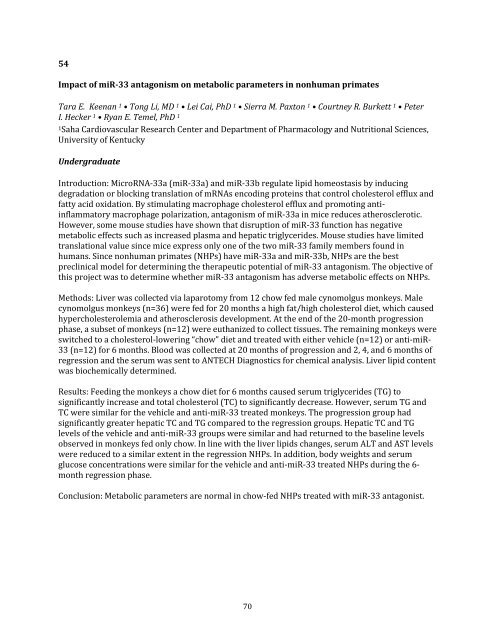2017 Cardiovascular Research Day Abstract Book
Create successful ePaper yourself
Turn your PDF publications into a flip-book with our unique Google optimized e-Paper software.
54<br />
Impact of miR-33 antagonism on metabolic parameters in nonhuman primates<br />
Tara E. Keenan 1 • Tong Li, MD 1 • Lei Cai, PhD 1 • Sierra M. Paxton 1 • Courtney R. Burkett 1 • Peter<br />
I. Hecker 1 • Ryan E. Temel, PhD 1<br />
1Saha <strong>Cardiovascular</strong> <strong>Research</strong> Center and Department of Pharmacology and Nutritional Sciences,<br />
University of Kentucky<br />
Undergraduate<br />
Introduction: MicroRNA-33a (miR-33a) and miR-33b regulate lipid homeostasis by inducing<br />
degradation or blocking translation of mRNAs encoding proteins that control cholesterol efflux and<br />
fatty acid oxidation. By stimulating macrophage cholesterol efflux and promoting antiinflammatory<br />
macrophage polarization, antagonism of miR-33a in mice reduces atherosclerotic.<br />
However, some mouse studies have shown that disruption of miR-33 function has negative<br />
metabolic effects such as increased plasma and hepatic triglycerides. Mouse studies have limited<br />
translational value since mice express only one of the two miR-33 family members found in<br />
humans. Since nonhuman primates (NHPs) have miR-33a and miR-33b, NHPs are the best<br />
preclinical model for determining the therapeutic potential of miR-33 antagonism. The objective of<br />
this project was to determine whether miR-33 antagonism has adverse metabolic effects on NHPs.<br />
Methods: Liver was collected via laparotomy from 12 chow fed male cynomolgus monkeys. Male<br />
cynomolgus monkeys (n=36) were fed for 20 months a high fat/high cholesterol diet, which caused<br />
hypercholesterolemia and atherosclerosis development. At the end of the 20-month progression<br />
phase, a subset of monkeys (n=12) were euthanized to collect tissues. The remaining monkeys were<br />
switched to a cholesterol-lowering “chow” diet and treated with either vehicle (n=12) or anti-miR-<br />
33 (n=12) for 6 months. Blood was collected at 20 months of progression and 2, 4, and 6 months of<br />
regression and the serum was sent to ANTECH Diagnostics for chemical analysis. Liver lipid content<br />
was biochemically determined.<br />
Results: Feeding the monkeys a chow diet for 6 months caused serum triglycerides (TG) to<br />
significantly increase and total cholesterol (TC) to significantly decrease. However, serum TG and<br />
TC were similar for the vehicle and anti-miR-33 treated monkeys. The progression group had<br />
significantly greater hepatic TC and TG compared to the regression groups. Hepatic TC and TG<br />
levels of the vehicle and anti-miR-33 groups were similar and had returned to the baseline levels<br />
observed in monkeys fed only chow. In line with the liver lipids changes, serum ALT and AST levels<br />
were reduced to a similar extent in the regression NHPs. In addition, body weights and serum<br />
glucose concentrations were similar for the vehicle and anti-miR-33 treated NHPs during the 6-<br />
month regression phase.<br />
Conclusion: Metabolic parameters are normal in chow-fed NHPs treated with miR-33 antagonist.<br />
70


